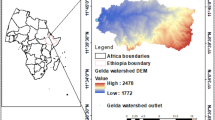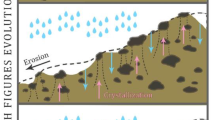Abstract
A variety of methods have been developed to process digital elevation models (DEMs) in order to extract morphological properties of land surfaces. Almost all rely on depression filling to facilitate drainage analysis. This study proposes an intuitive and relatively simple depression-filling algorithm, which is readily applicable to raster and irregular datasets. In this study, topographic data of two watershed areas were provided to test the capability of this new algorithm. The results show that the proposed algorithm can accurately identify the locations of depressions and efficiently assign pseudo flow directions across the filled depressions.

















Similar content being viewed by others
References
Douglas D H 1986 Experiments to locate ridges and channels to create a new type of digital elevation model; Cartographica 23 (4) 29–61.
Freeman T G 1991 Calculating catchment area with divergent flow based on a regular grid; Comput. Geosci. 17 413–422.
Goodrich D C, Woolhiser D A and Keefer T O 1991 Kinematic routing using finite elements on a triangular irregular network; Water Res. Res. 27 (6) 995–1003.
Ivanov V Y, Vivoni E R, Bras R L and Entekhabi D 2004 Catchment hydrologic response with a fully distributed triangulated irregular network model; Water Resour. Res. 40 11. doi: 10.1029/2004WR003218.
Jenson S K and Domingue J O 1988 Extraction topographic structure from digital elevation data for geographic information system analysis; Photogramm. Eng. Remote Sens. 54 (11) 1593–1600.
Lee K T 1998 Generating design hydrographs by DEM assisted geomorphic runoff simulation: A case study; J. Am. Water Resourc. Assoc. 34 (2) 375–384.
Liang C J and Mackay D S 2000 A general model of watershed extraction and representation using globally optimal flow paths and up-slope contribution areas; Int. J. Geogr. Infor. Sci. 14 (4) 337–358.
Marks D, Dozier J and Frew J 1984 Automated basin delineation from digital elevation data; Geo-Processing 2 299–311.
Martz L W and Jong E D 1988 CATCH: A Fortran program for measuring catchment area from digital elevation models; Comput. Geosci. 14 627–640.
Martz L W and Garbrecht J 1998 The treatment of flat areas and closed depressions in automated drainage analysis of raster digital elevation models; Hydrol. Process. 12 843–855.
Martz L W and Garbrecht J 1999 An outlet breaching algorithm for the treatment of closed depressions in a raster DEM; Comput. Geosci. 25 835–844.
O’Callaghan J and Mark D M 1984 The extraction of drainage networks from digital elevation data; Comput. Vision Graphics Image Process 28 323–344.
Qu Y and Duffy C J 2007 A semi-discrete finite volume formulation for multiprocess watershed simulation; Water Resour. Res. 43 8. doi: 10.1029/2006WR005752.
Wang L and Liu H 2006 An efficient method for identifying and filling surface depressions in digital elevation models for hydrologic analysis and modeling; Int. J. Geogr. Infor. Sci. 20 (2) 193–213.
Acknowledgements
This research was supported by the Ministry of Science and Technology, Taiwan, ROC, under grant NSC 103-2923-E-019-001-MY3. Digital elevation datasets provided by Taiwan Aerial Survey Office, Forestry Bureau, and Agricultural Research Service, United States Department of Agriculture are gratefully acknowledged.
Author information
Authors and Affiliations
Corresponding author
Rights and permissions
About this article
Cite this article
Huang, PC., Lee, K.T. A simple depression-filling method for raster and irregular elevation datasets. J Earth Syst Sci 124, 1653–1665 (2015). https://doi.org/10.1007/s12040-015-0641-2
Received:
Revised:
Accepted:
Published:
Issue Date:
DOI: https://doi.org/10.1007/s12040-015-0641-2




